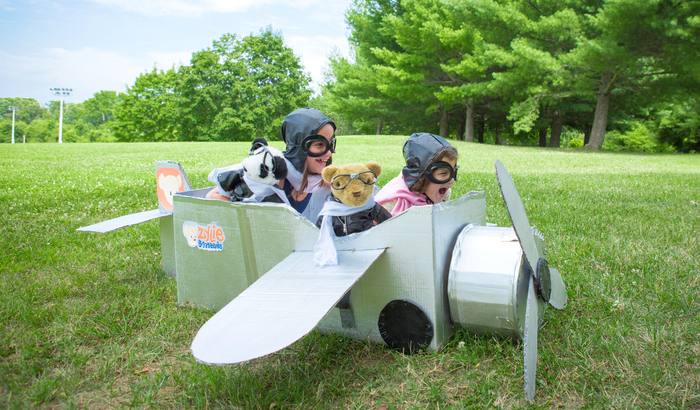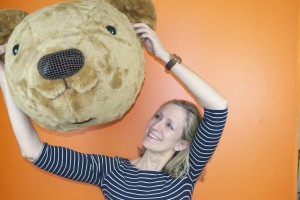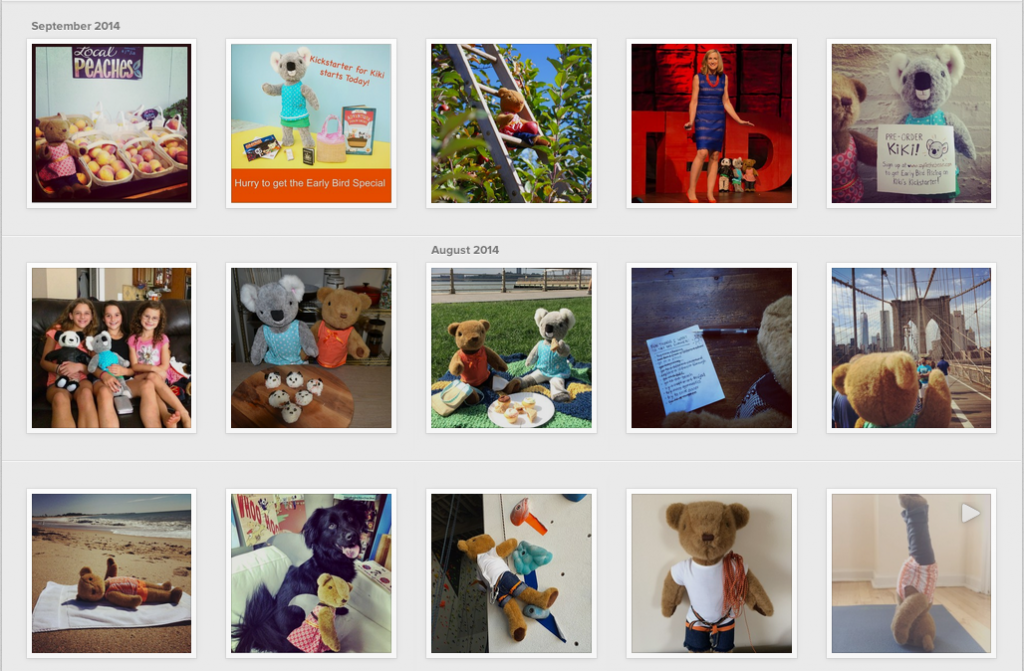
How does a family start-up with a throwback idea and not a lot of capital break into an industry dominated by corporate giants?
Five years ago, Mary Beth Minton and her son Matt McCarty started their company Zylie & Friends around a single product, a teddy bear that Minton had sewn herself.
Now their award-winning bear, Zylie, and a growing pack of stylishly dressed toy bears, each with a passport, map, and a travel diary, hailing from foreign countries, are in over 600 stores nationwide.
Zylie has appeared on national television, on a recent TEDx stage during Minton’s talk “Unplug to Play,” and has fans around the world–from the YouTube celebrity family the Bratayleys (with half a million followers) to the thousands of ordinary kids who follow Zylie on Instagram.
Not bad for a little bear created as an antidote to too much screen-time.
So what can the rest of us learn from Minton and McCarty’s experience?
Just Try It
Twenty years ago, Minton, a young mother with three children, had a problem. Like many other parents she saw that kids (her own included) were spending way too much time in front of the screen and not enough time in imaginative play. Back then psychologists were beginning to predict the deleterious effects of screen time on a child’s future creativity and innovation. So Minton decided to do something about it. She joined an advocacy group. She even had an appointment with then-president Bill Clinton. How did that work out? Her Clinton appointment was cancelled “due to an international crisis” Minton told us.
After two decades of advocacy, Minton had to admit that hectoring parents or trying to get the government involved hadn’t made a shred of difference. “In fact, it’s become worse,” says Minton. When her kids were young, it was just TV. Now screens are everywhere. According to the American Academy of Pediatrics, kids 8 to 10 spend an average of eight hours a day in front of screens.
 If advocacy wasn’t the answer, Minton wondered what could she do to get kids off screens? Then she had an audacious idea: She’d fight the immersive experience of an app or a video game with . . . a teddy bear.
If advocacy wasn’t the answer, Minton wondered what could she do to get kids off screens? Then she had an audacious idea: She’d fight the immersive experience of an app or a video game with . . . a teddy bear.
Creating an analog toy, even one covered in fur with buttons for eyes, might seem like weak competition for an addictive online game. But in 2009 Minton made a prototype on her kitchen table and Zylie, an 18-inch jointed bear, was born.
When Minton pitched the idea to fellow MBA alums from Wharton, they offered this advice: Introducing a teddy bear into a $20 billion toy market was startup suicide. You might as well take a million dollars and rip it up.
But Minton wasn’t so easily discouraged. Neither was her son, a recent college grad with a minor in economics and a major in philosophy. McCarty believed deeply in his mother’s mission to get kids to unplug to play. And where others saw folly, he saw an opportunity. “Like a lot of small businesses, I recognized that we could use our advantage of being small and learn to test out new ideas, be more flexible, and reach our customers directly,” he says.
One day, McCarty marched into his boss’s office at a marketing startup in Denver and declared: “I’m quitting to go sell teddy bears with my mother.”
“Starting a business is so full of uncertainty,” says Minton. “You need a mental attitude to cope with it or you’ll be waylaid by debilitating doubt.” So they came up with the mantra “Just Try It” and put the three-word phrase on their office wall lest they forget it. And when they get to a decision point, after having weighed all the pros and cons and one or the other is still vacillating, they remind each other of their mantra.
Be So Good They Can’t Ignore You
When the mother and son team started out they had minimal cash reserves to compete with the rest of the toy industry. They needed something else to get the attention of retailers.
In 2010, with their teddy bear still in prototype, they entered it into half a dozen contests. Zylie & Friends swept the season’s competitions, including winning a platinum award in one of the industry’s most prestigious competitions, the Oppenheim Toy Portfolio, which landed Zylie on the Today Show.
That got the attention of the industry, which led to a coveted cobranding deal with F.A.O. Schwartz (now owned by Toys”R”Us), which put Zylie & Friends into 600 stores nationwide.
“If you’re a small business you don’t have the marketing budget or the reputation yet, all you have is your product,” says Minton. Even now with a foothold in the industry, they remain focused on quality. “We spend every dollar and most of most of our time on improving our products.”
Trust Your Instincts
 “As the small guy you need the advice of experts,” says McCarty. “But it’s important to recognize that expertise will not always pay off.”
“As the small guy you need the advice of experts,” says McCarty. “But it’s important to recognize that expertise will not always pay off.”
Of course, their company has benefitted from outside experts, including, for example the redesign of Zylie’s face. “In my prototype, Zylie looked like a gopher,” admits Minton, an amateur seamstress. “I needed help.” Reaching out to a puppet designer who has designed Disney characters for Broadway, Minton saw that the designer was much more adept at creating a face that was truly expressive. “It was worth the expense, she got Zylie’s face just right,” Minton said.
But Minton and McCarty have had to learn the hard way that sometimes working with an “expert” can set you back. For their first overseas manufacturing order Minton and McCarty had to hire a shipping agent. “We had a bad feeling about him from the beginning,” says Minton. “We were picking up warning signals, like the way he was acting so insulted when we asked him for references. But we rationalized working with him by telling ourselves that he knew best.”
Not only did the agent charge them an exorbitant rate, but he held hundreds of Zylies hostage in a shipping container.
Now Minton and McCarty know that if the “expert” advice they’re getting seems inappropriate, it probably is. As counterintuitive (and daunting) as it may seem, they realize that often they’re much more qualified to handle a task than a more experienced person–doing their own social media, for example–because “we understand our product so well,” says McCarty.
Be Your Customers’ BFF
Mattel and Hasbro rely on what is known in the industry as pester power: Enormous ad campaigns aimed at young consumers during kids’ shows and embedded into apps and video games. “Forty million toys are thrown out each year. And the companies are fine with that,” says McCarty. “A kid who loses a toy needs a new one. Planned obsolescence. It’s wrong for a lot of reasons, but it’s also an opportunity for us to do something differently.”
For Minton and McCarty, selling one of their bears is just the beginning of their relationship with the customer. The long-term viability of their company depends on Zylie and her cohorts being more than a fad. So how do you make loyal customers out of 4 to 10 year olds?
“Kids are always wanting more stories and more characters to keep the energy and spirit alive,” says McCarty. “It’s up to us to keep that relationship with Zylie and Friends meaningful to them.”
Zylie and her pals come with storybooks about the bears’ adventures. And Minton and McCarty are experimenting with other content-rich, adventure-related activities, including a monthly post-card subscription from Zylie’s visits to far away places.
And Minton took over the company’s Instagram site, posting photos of Zylie on adventures and encouraging kids to try out Zylie’s adventures and post photos of their own Zylies. For Minton and McCarty this dialogue with their customers works both ways. Feedback is valuable knowledge from their fan base to find out directly from the customers what they want.
For example, Zylie fans let Minton and McCarty know they want the next bear in the Zylie and Friends series, Kiki the Koala, whose first run production is being crowdfunded through a Kickstarter campaign. “The kids have asked for Kiki and we’ve responded, not just to raise funds but to make new friends who will stay connected to the Zylie experience,” says McCarty.
Whether it’s cross-branding with a YouTube family that’s wild about their product, or hearing from Zylie fans through social media, McCarty and even Minton admits that technology can be a wonderful thing.
“We use tech smartly,” says Minton, “to spark kids’ imagination to go try something else.”
A version of this story appeared in Fast Company.
Order “The Art of Doing” here. Signup for “The Art of Doing” free weekly e-newsletter. Follow us on Twitter. Join “The Art of Doing” Facebook Community. If you’ve read “The Art of Doing” please take a moment to leave a review here.

